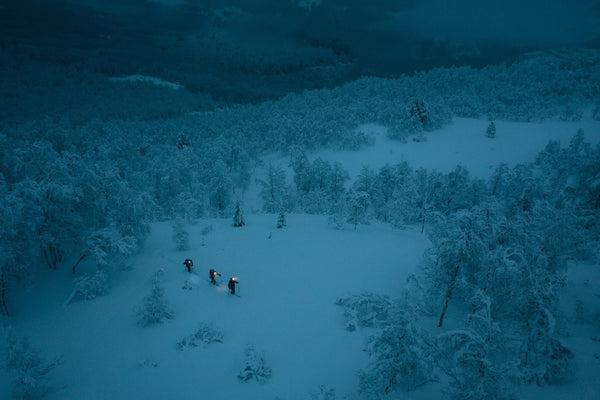Tutorial: How to progress on Touring skis (intermediate/advanced level)
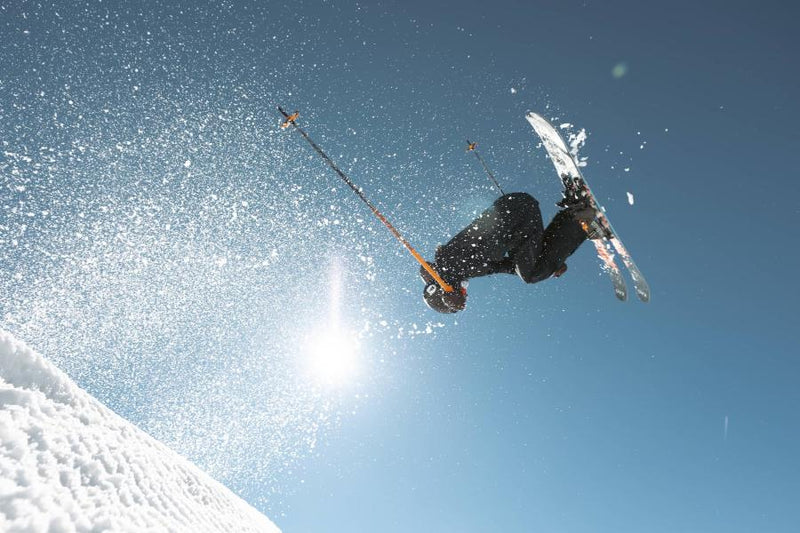
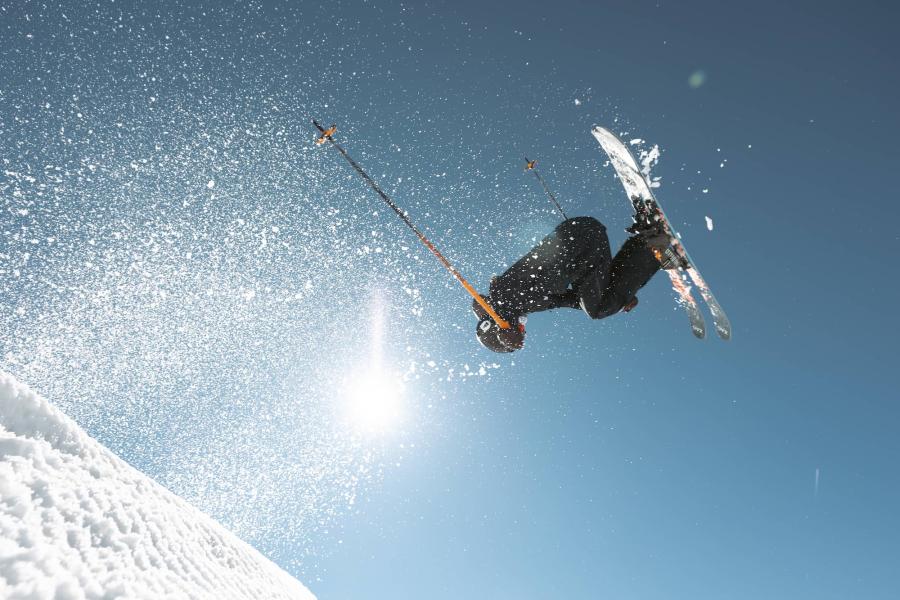
If you're a skier who's used to Touring ski outings, and you enjoy riding the little nuggets that are still less coveted, this blog is for you!
In our experience, many skiers embark on outings without being fully aware of many aspects, including safety. So in this article, we're going to give you a little ZAG skis refresher course to ensure that your outings are a success, and in complete safety!
In this blog, we'll try to review everything a Touring or freeride skier needs to know to be able to perform in his or her own backyard.
For some, this will simply allow them to check what they've learnt (here checked by a guide), while for others it will be a chance to continue their learning with a short pit stop, to get a good grounding in theory! To do this, we'll be accompanied by our regular guide, Pierre Masbou (aka Pierro).
Who is Pierre Masbou?
My name is Pierre Masbou, I'm an aspirant guide and ski instructor by training. I currently work as a Gendarme secouriste - trainer at the Gendarmerie's national ski and mountaineering center (CNISAG, center de formation pour le secours en montagne). I started mountain and Touring skiing in my native mountains, the Pyrenees. A famous quote that has stayed with me since my early days: "The mountaineer is a man who leads his body to where, one day, his eyes have looked...".
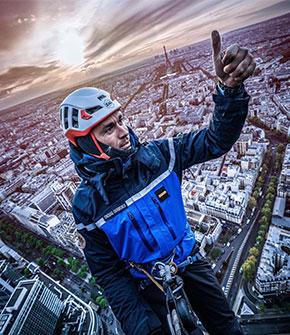
What equipment should you choose for Touring skiing?
In the quest to save weight, we often gamble on what gear to take along (or not). A difficult choice when you don't necessarily know what sauce you're going to be eaten with during your outing!
Knowing what equipment to take with you is a vital step in preparing for your outing! If you don't take enough, you run the risk of getting stuck in the middle of a tricky passage, and conversely, if you take too much, you'll tire yourself out unnecessarily.
In general, for a day outing, your backpack should hold between 20 and 30 liters. This allows you to pack enough layers for the weather, take your crampons or ice axe with you if you need to, load the food you need...
Pierro's words
"If you don't like a decision or a passage, don't hesitate to say so. Communication is a key element in any group outing. Accidents often happen when weaker people don't necessarily want to say that they're not doing well or don't feel it, and on the other hand, a crazy dog can lead you to find yourself in critical situations without having taken the time to analyze the terrain and the environment."
"The double check should be carried out to ensure that all avalanche transceivers are in good working order. It is possible that the frequencies of some avalanche transceivers have drifted and that these devices are no longer compatible with the others.
In general, I put my avalanche transceiver in a secure pocket in my pants (Leach system for attaching it to the inside) and my telephone in the opposite pocket in my jacket or even at the top of my rucksack. It's not only electronic devices that can interfere with the waves, but also the packaging on fruit compotes and cereal bars, which can make your avalanche transceiver malfunction!
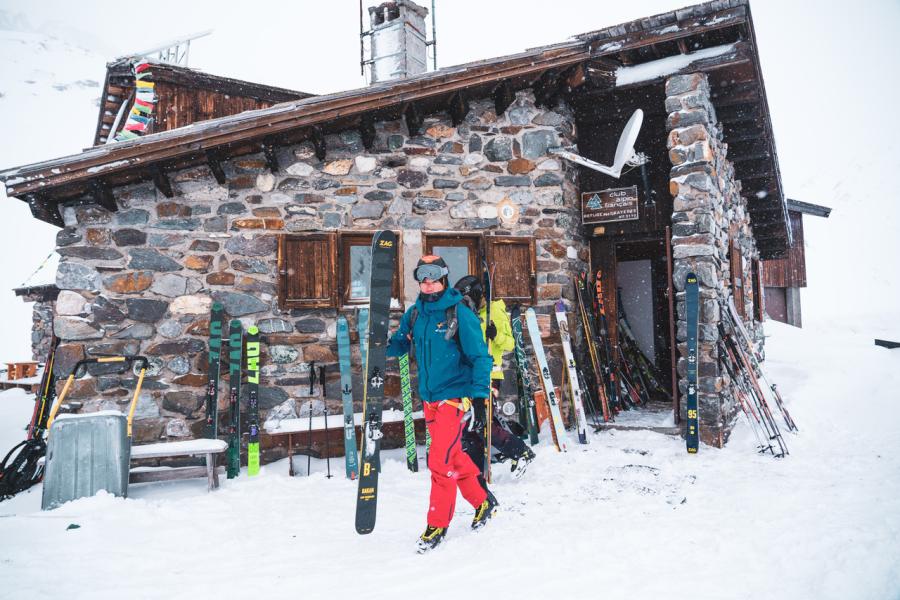
How do you start your Touring outing?
Starting-block
Now let's get down to the nitty-gritty: you've prepared for your outing in advance and arrive at the parking lot ready to strap on your skis and tackle the steep slopes. But not so fast! Nothing beats a good personal weather forecast. It's important not to overlook the team's state of mind. Knowing everyone's motivations will enable us to adapt the outing to suit as many people as possible. You're never safe from someone who's less fit, or someone who wants to eat up as much D+ as possible in as little time as possible, so it's important to be aware of this to avoid frustration within the team.
With your personal weather forecast in hand, an analysis from the parking lot of the sky, snow, possible avalanches, etc. will give you a direct idea of the environment in which you'll be evolving. You start the outing, but not so fast either! Two people will need to be designated for the DVA test. Spaced out, one by one you'll pass in front of your colleague, starting with the "Search" mode (one meter away from him) and then passing in front of the second with the "Ski" mode.
Once everyone's been checked, you can set off on your outing with peace of mind (if no signs of trouble have been detected, of course).
Check DVA ok but watch out for interference!
For your DVA to work properly, it's essential to eliminate as much interference as possible. Interference can be caused by any electronic device (even switched off/airplane mode for smartphones). The closer the device is to the DVA, the more it interferes with the DVA's waves. At the very least, keep electronic/metallic devices 50cm away from the device. Aside,
Now it's off, and as the horses are launched, it's easy to see who's got the most and who's got the least, chatting away. I don't need to remind you that when you make a physical effort, you sweat and you get hot. Good diaper management is important. After a quarter of an hour's effort, don't hesitate to take a break, reunite the group and ask everyone how they're feeling (personal weather report part 2), remove a layer if necessary, create new groups if you need to, and get on with it!
Pierro's words
"If you don't like a decision or a passage, don't hesitate to say so. Communication is a key element in any group outing. Accidents often happen when weaker people don't necessarily want to say that they're not doing well or don't feel it, and on the other hand, a crazy dog can lead you to find yourself in critical situations without having taken the time to analyze the terrain and the environment."
"The double check should be carried out to ensure that all avalanche transceivers are in good working order. It is possible that the frequencies of some avalanche transceivers have drifted and that these devices are no longer compatible with the others.
In general, I put my avalanche transceiver in a secure pocket in my pants (Leach system for attaching it to the inside) and my telephone in the opposite pocket in my jacket or even at the top of my rucksack. It's not only electronic devices that can interfere with the waves, but also the packaging on fruit compotes and cereal bars that can make your avalanche transceiver go awry!
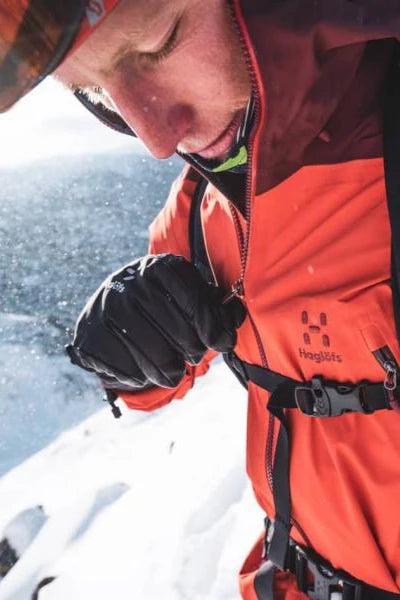
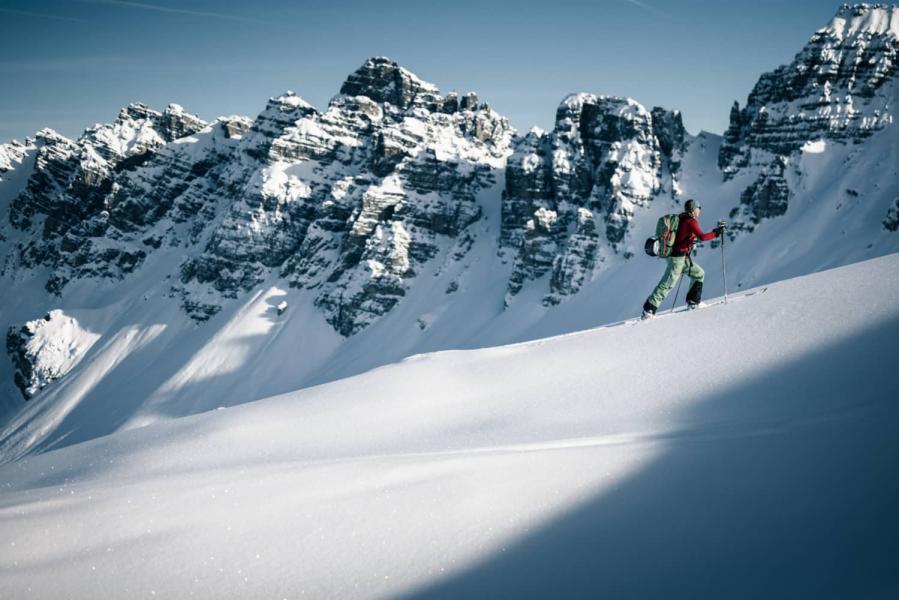
How do you analyze the terrain?
We're moving forward, we're moving forward, we know right away where to go because we've prepared the exit well, but a doubt arises on a slope. Hooop we don't rush headlong, we make a decision.
Munter's 3x3, the Swiss Army Knife of decision support
This simple method enables you to make quick decisions. It is based on three factors: people, conditions and terrain at three spatio-temporal levels: before, in the parking lot and in the field.
Before : Consult the Bulletin du Risque d'Avalanches (Avalanche Risk Bulletin) and find out which route to take.
Parking: Personal weather forecast. Do a quick briefing with the people you're setting off with on their state of mind, motivation and expectations for the outing.
Terrain: Constantly analyze the terrain and revise your itinerary if conditions turn out not to be as expected.
Speaking of which, let's take a break for a quick nivo point!
In winter, and especially when Touring, avalanches are a skier's number one enemy.
What is an avalanche? It's the overlapping of two layers of snow, or "slabs", of different densities. An avalanche is triggered when the lower layer (slab) has a lower density than the upper layer (slab).
The passage of a skier is enough to trigger a slab several tens of metres long and several thousand cubic metres in size.
To get a local feel for the snowpack and its layers, simply invert your Pole and stick it into the snow. You'll quickly feel different densities as you push.
Pierro's words
"The 3x3 method is one of the risk analysis methods I use regularly on my Touring ski outings, alone or with my clients. It's very important to be able to ask the right questions at the right time!
The most complicated thing to analyze and interpret is snow conditions! If you want to improve your skills and test your knowledge of snow conditions, don't hesitate to ask a mountain pro for advice on one or more outings. "
Avalanche risk? Be vigilant!
The 4 vigilance modes
Relaxed mode: You're in an area where the slopes are less than 30°, there are no visible signs and you're out of reach of any starters.
Caution mode: You are aware that you are potentially in a high-risk area, but that you can avoid the danger by following your route. The aim is to clearly distinguish the dangerous section in order to adapt your route and avoid the danger.
Alerted mode: You enter a zone where there is a risk of avalanche, either because the itinerary requires it or because you choose to do so. The aim here is to distinguish islands of safety, lengthening the distances between skiers (fewer people involved if an avalanche is triggered).
Hazardous mode: You are operating in an area where it is impossible to reduce the risk - in the worst case, the outcome is fatal. Hire only well-informed, aware people.
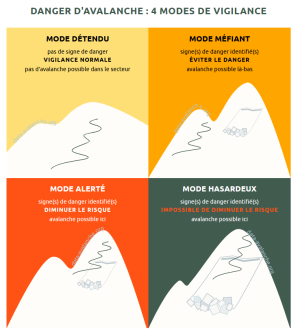
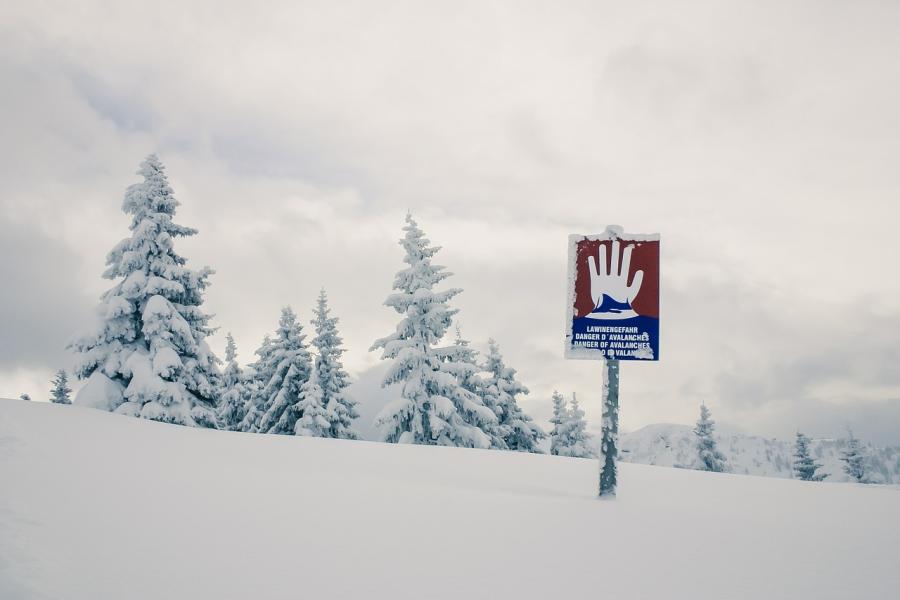
Duclos pictograms
The Duclos pictograms are another useful tool to help you with nivology and progress. There are 6 of them to give you an overview of your progress.
Recent avalanches: Information on recent avalanches is available via the Internet (data-avalanche.org).
Slopes: From the IGN or Skitrack websites, it's easy to display slopes of over 30°.
Risk index: Based on BERA data published from December 15 to April 15 on the Météo France website.
Surcharge: Thickness of fresh snow, accumulation due to wind, recent or not.
Thawing: A rise in temperature and possibly associated thawing are easily perceptible.
Fragile layers: Buried layers and their effect on the stability of the snowpack. Good monitoring of local weather and snow conditions can provide information on the presence of these layers.
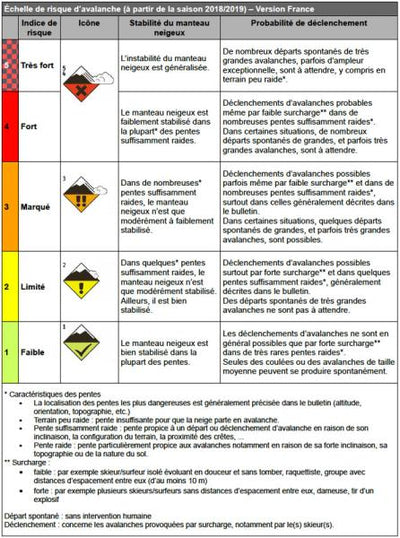
To refer to the BERA avalanche risk scale, here's a brief summary of the signs you may encounter.
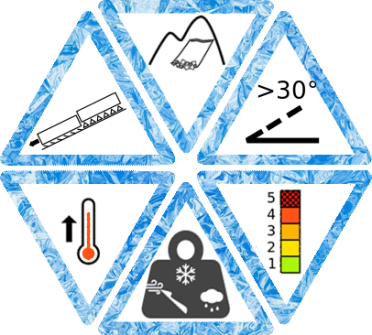
Pierro's words
"The ARO is an element that, like the weather, is taken into account in race preparation, but also in the field. The pictograms and the 4 vigilance modes are decision-making aids in the field that fill in the decision boxes in the 3X3 method.
Zero risk does not exist. Snow is a complex element, and the more you know about it, the less you know! The only small piece of advice I can give you is to take safe distances to avoid exposing the whole group as soon as possible."
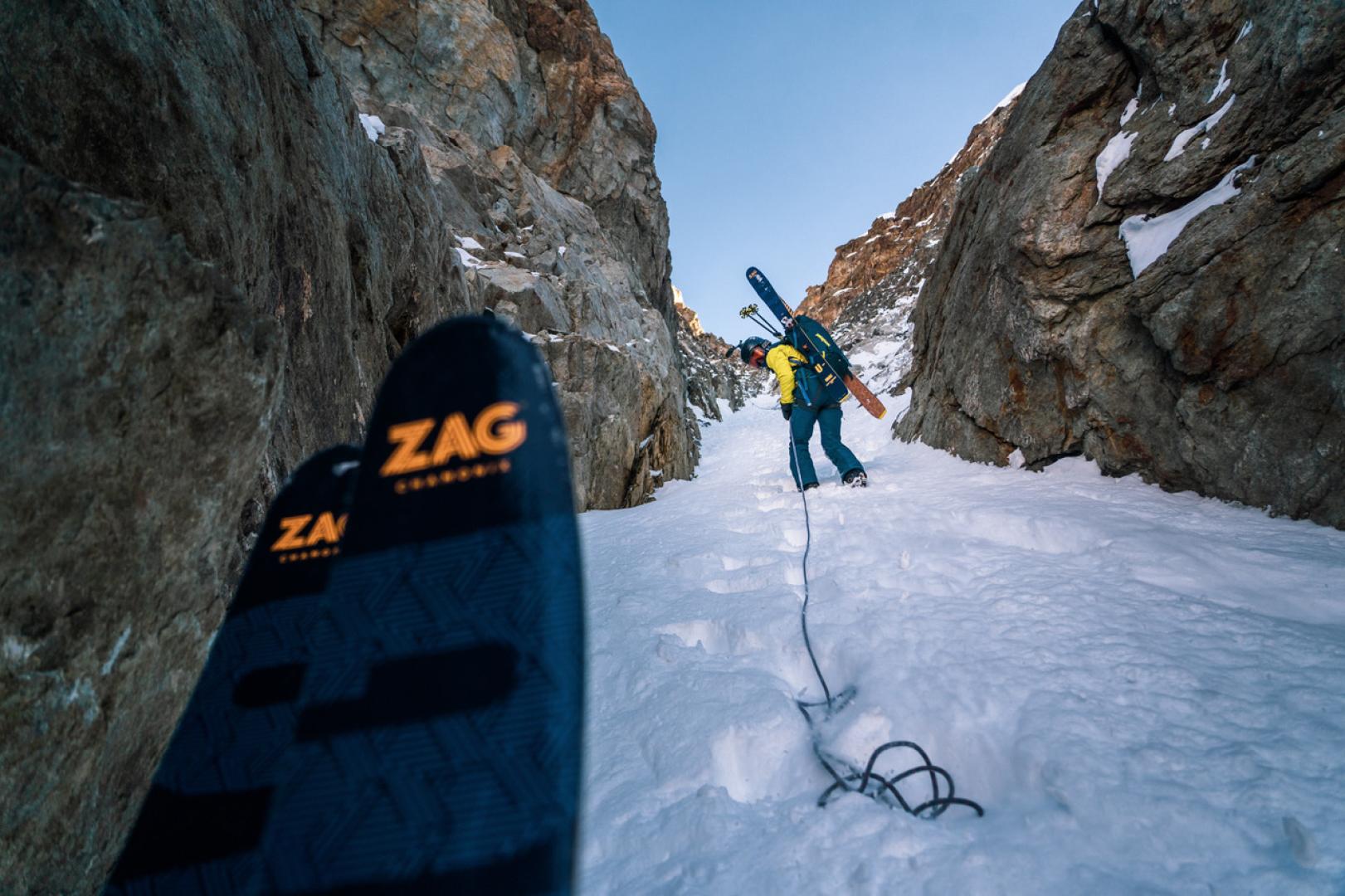
How do you get around hazardous terrain?
It goes without saying that as you progress, you quickly get fed up with outings with marked-out slopes of less than 30°, where you come across half the CAF from the next town.
We're in the mood for something new, to push the limits a little and see what lies between two summits, explore some couloirs, do some ridge running, progress on glacier...
But it doesn't happen without preparation! Here's a quick checklist of useful things to know before you commit!
Useful nodes
- The basic rope-tie knot is the 8-knot, used to tie in at the end of the rope as well as to connect the two abseil ropes.
- The capstan is an adjustable knot used to secure oneself.
- The half-cabestan is a belay knot used to anchor a person or abseil short distances.
How to use an ice axe/what type of ice axe to choose?
The ice axe is useful for technical outings in high alpine and glacier terrain. It can be used as a walking aid and a safety feature on steep slopes in hard or even icy snow. It is generally used in conjunction with crampons for added safety. For example, we recommend a PETZL Gully light ice axe and PETZL Irvis hybrid steel/aluminum crampons.
Of course, it's important to choose the equipment that's right for your level and practice. If you don't know how to use your equipment properly, you may find it too powerful. Light doesn't mean practical/ easy to use.
How to rope up on a ridge or glacier?
The minimum rope length on glacier is 15m between each climber. A reserve of rope must be kept by the leader and the last climber to be able to initiate a rescue (hauling in) in the event of a fall into a crevasse. The rope is put in place as soon as a traverse on a crevassed glacier is made. On the other hand, don't forget to take your personal equipment for progression and rescue in crevasses (lanyard, ice pins, 120cm straps, traction pulley, mechanical self-locking device and a small 8m cord). A half-strand of abseiling is all you need for glacier climbing.
There is no standard length for roping on ridge routes. The most important thing for easy progression with a taut rope is to place a minimum of two safety points (quickdraws on gougeons or spits, straps on cleats, friends, belay clamps) between the leader and the second. The ropes used for ridge running are either one or two strands of doubled abseil or a single rope.
How do you protect a ski run?
During ski descents on slopes over 30° and where the snowpack is estimated to be in mistrust mode (4 vigilance modes), I make people leave one by one. I make them stop at a place where the risk is reduced. When skiing steep slopes, I follow the same procedure.
On the glacier, you must be vigilant. Leave some space between you. The last skier must be able to lie down at any moment to hold back the skier in front of him who could fall into a crevasse.
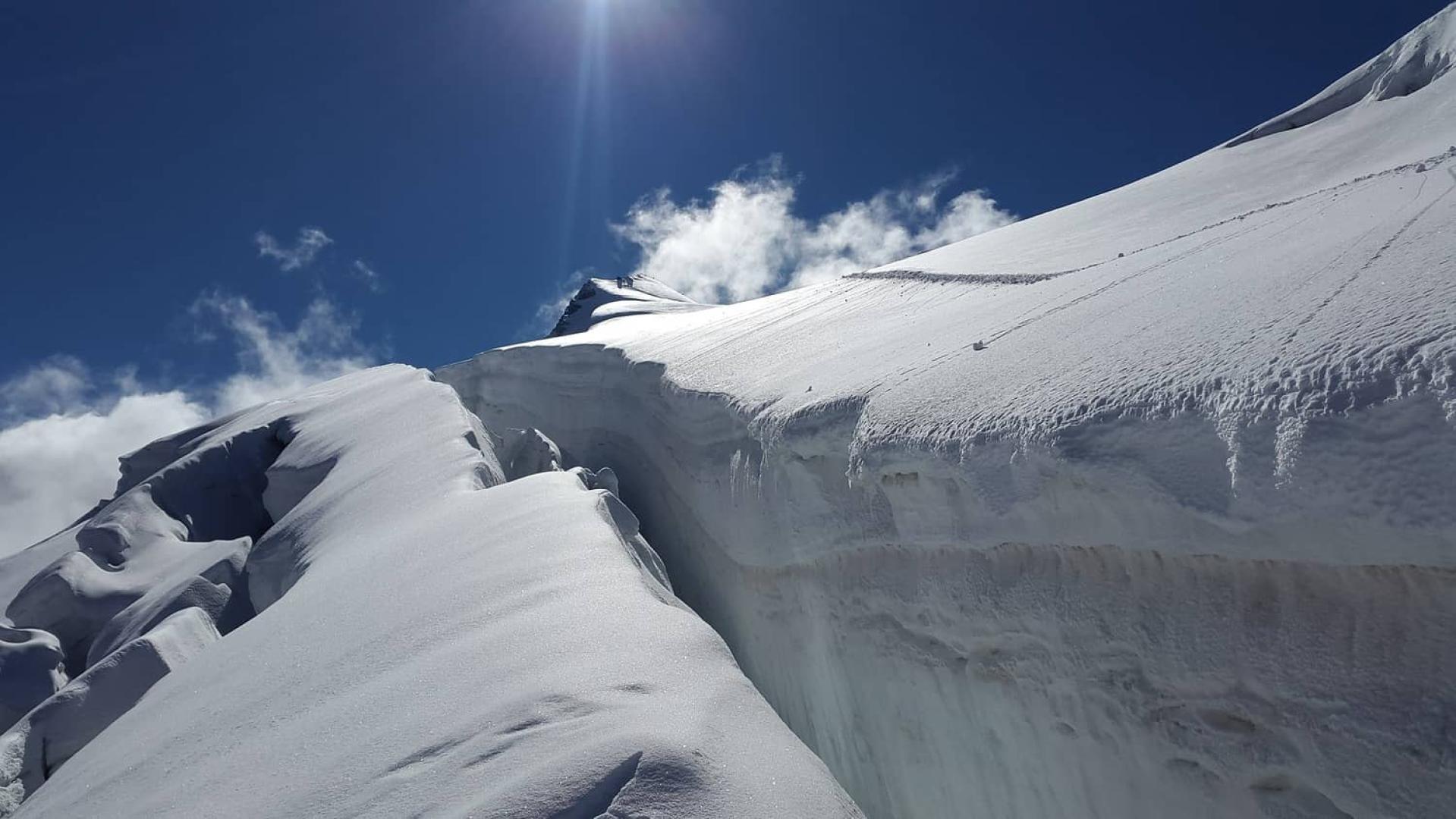
How do you rescue someone in an avalanche?
When someone is caught in an avalanche, time is of the essence. The person's vital prognosis decreases very quickly (usually within a quarter of an hour). That's why it's vital to know the right thing to do to save the person, and to eliminate all the "parasitic" gestures.
1. Elect a leader
2. Alert emergency services
3. Organize your search
4. Securing the site
5. Carry out searches
All members of the group must be able to carry out an avalanche search with their avalanche transceiver! Several times a year, the CAF organizes training sessions for this purpose.
We strongly advise you to watch this short video.
It's very intuitive, so you'll quickly understand what's at stake and what you need to do!
Pierro's words
"La Chamoniarde's video is very well done.
DVA search training must be carried out regularly throughout the winter season to ensure that you know your equipment and can be effective on the big day.
When it comes to avalanche organization, here's what I can tell you:
Completely buried people need to be removed as quickly as possible. It's important to alert the emergency services, but the most urgent thing is to get the buried person(s) out.
In this situation, the leader will emerge naturally. Beware of wasting unnecessary time. Search for DVA. Look and shoot for surface clues. Once you've found the person(s), apply first aid. Beware: avalanche victims can be polytraumatized.
Always be aware of the risk of over-avalanche. Most new avalanche transceivers automatically switch to transmit if you get caught in an over-avalanche while searching (not all devices do this, something to check when purchasing)."
How do you rescue someone from a crevasse?
The key gestures
The ENSA video explains and demonstrates perfectly what you should do when the person is unharmed at the end of the rope. If your companion is injured or unconscious, secure the rope, call for help and start manipulating the top rope pulleys (single or double mariner).
Alerting emergency services
To alert emergency services, use either the radio or your cell phone (112).
How can you improve your practice?
As you know, year after year we see our playground deteriorating as a result of human action.
Acting on your own scale means being responsible. So, through the ZAGreen program, we've tried to think of different ways of reducing our impact on an industrial scale, but we're not the only ones who have a role to play!
Experienced skiers are used to transportation. It's still rare to have good alternatives to the car for getting to our remote corners. But we can be smart about it and organize carpooling with friends.
If you're climbing in the high mountains, you'll sometimes have to use anchors. Try as much as possible to leave no trace of your passage by using temporary protection (rings, stoppers, pins, friends...) rather than pitons!
It's nothing new, but those who love the mountains respect them. Waste is in the bag!
If you're interested in this topic, take a look at our dedicated page.
